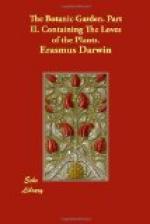[Digitalis. l. 425. Of the class Two Powers. Four males, one female, Foxglove. The effect of this plant in that kind of Dropsy, which is termed anasarca, where the legs and thighs are much swelled, attended with great difficulty of breathing, is truly astonishing. In the ascites accompanied with anasarca of people past the meridian of life it will also sometimes succeed. The method of administering it requires some caution, as it is liable, in greater doses, to induce very violent and debilitating sickness, which continues one or two days, during which time the dropsical collection however disappears. One large spoonful, or half an ounce, of the following decoction, given twice a day, will generally succeed in a few days. But in more robust people, one large spoonful every two hours, till four spoonfuls are taken, or till sickness occurs, will evacuate the dropsical swellings with greater certainty, but is liable to operate more violently. Boil four ounces of the fresh leaves of purple Foxglove (which leaves may be had at all seasons of the year) from two pints of water to twelve ounces; add to the strained liquor, while yet warm, three ounces of rectified spirit of wine. A theory of the effects of this medicine, with many successful cases, may be seen in a pamphlet, called, “Experiments on Mucilaginous and Purulent Matter,” published by Dr. Darwin in 1780. Sold by Cadell, London.]
So
when Contagion with mephitic breath
And
withered Famine urged the work of death;
435 Marseilles’ good Bishop, London’s
generous Mayor,
With
food and faith, with medicine and with prayer,
Raised
the weak head and stayed the parting sigh,
Or
with new life relumed the swimming eye.—
440 —And now, PHILANTHROPY! thy rays divine
Dart
round the globe from Zembla to the Line;
O’er
each dark prison plays the cheering light,
Like
northern lustres o’er the vault of night.—
[Marseillle’s good Bishop. l. 435. In the year 1720 and 1722 the Plague made dreadful havock at Marseilles; at which time the Bishop was indefatigable in the execution of his pastoral office, visiting, relieving, encouraging, and absolving the sick with extream tenderness; and though perpetually exposed to the infection, like Sir John Lawrence mentioned below, they both are said to have escaped the disease.]
[London’s generous Mayor, l. 435. During the great Plague at London in the year 1665, Sir John Lawrence, the then Lord Mayor, continued the whole time in the city; heard complaints, and redressed them; enforced the wisest regulations then known, and saw them executed. The day after the disease was known with certainty to be the Plague, above 40,000 servants were dismissed, and turned into the streets to perish, for no one would receive them into their houses; and the villages near London drove them away with pitch-forks and fire-arms. Sir John Lawrence supported them all, as well as the needy who were sick, at first by expending his own fortune, till subscriptions could be solicited and received from all parts of the nation. Journal of the Plague-year, Printed for E. Nutt, &c. at the R. Exchange. 1722.]




